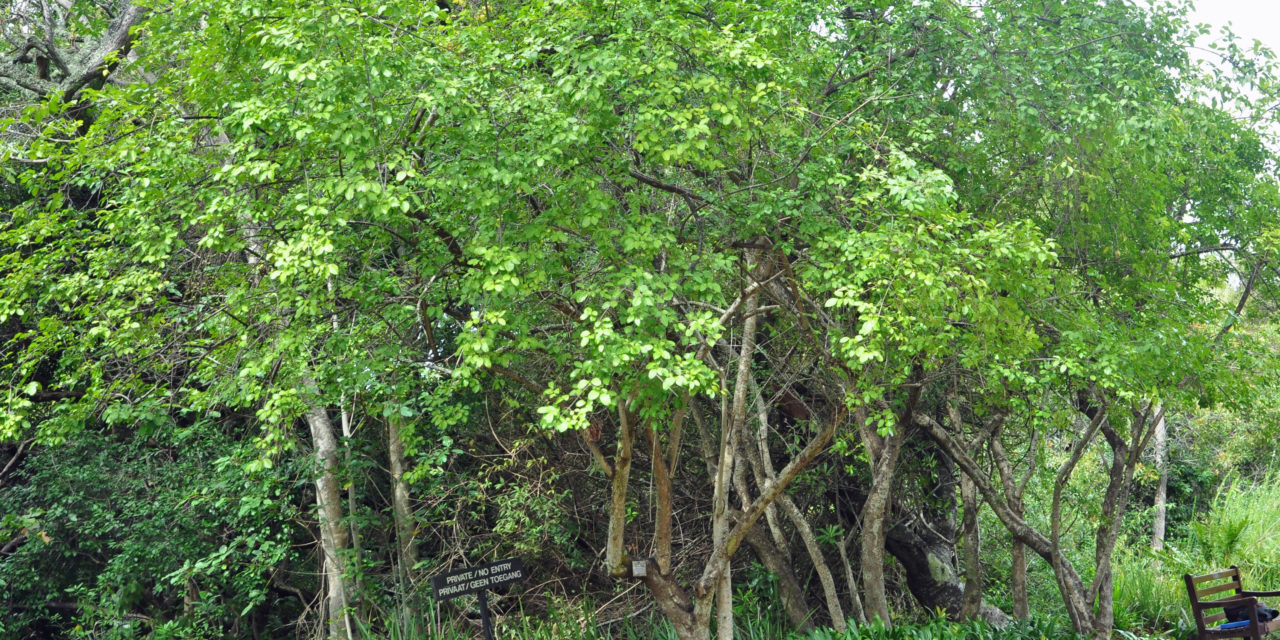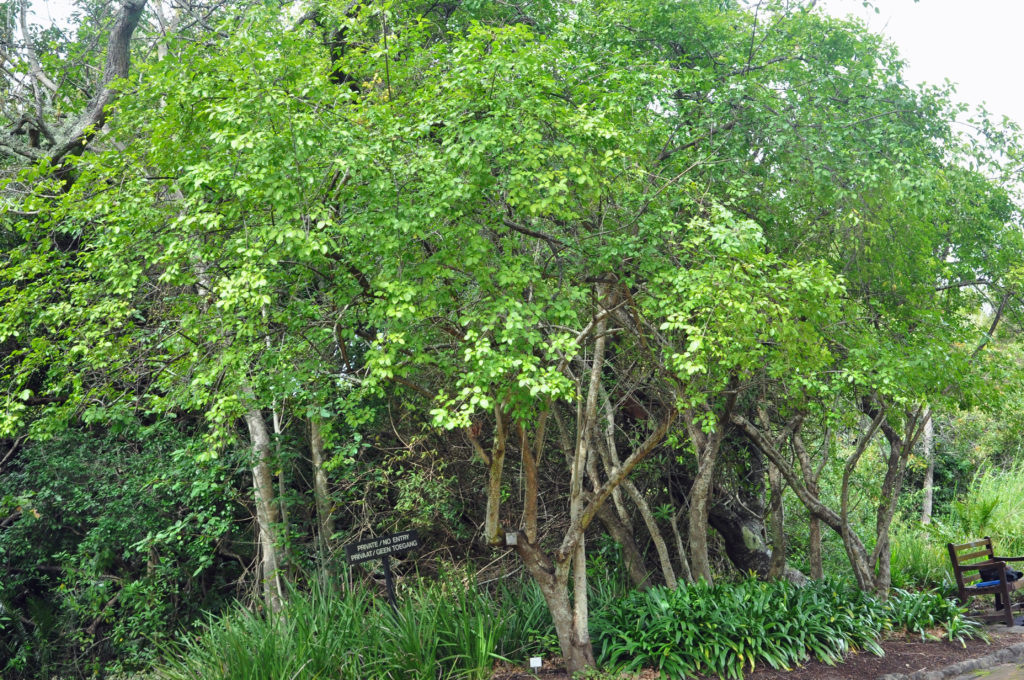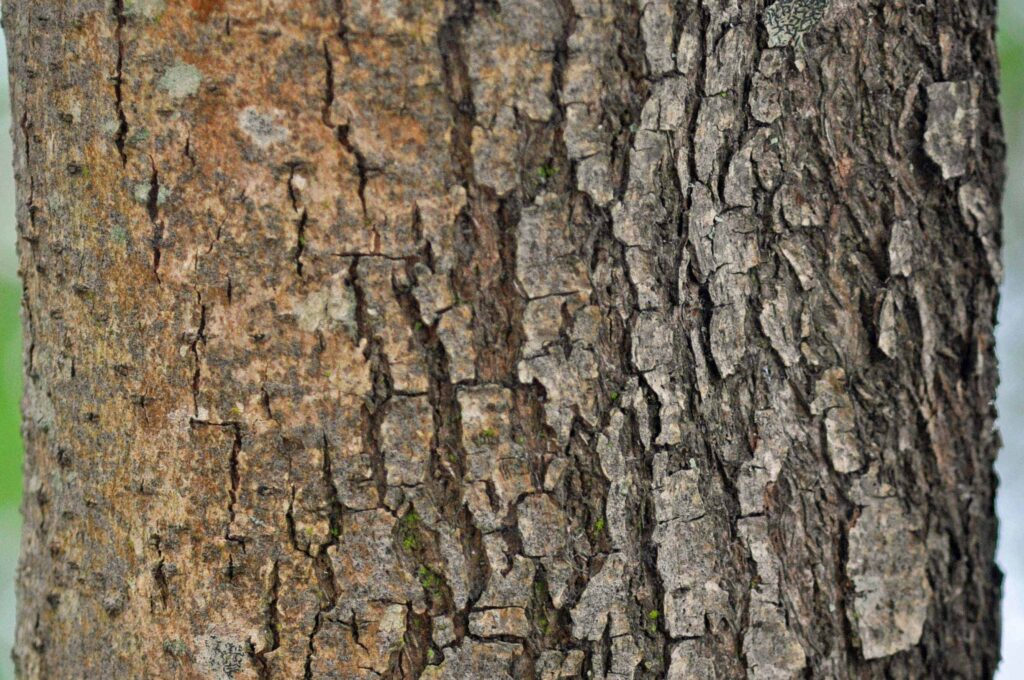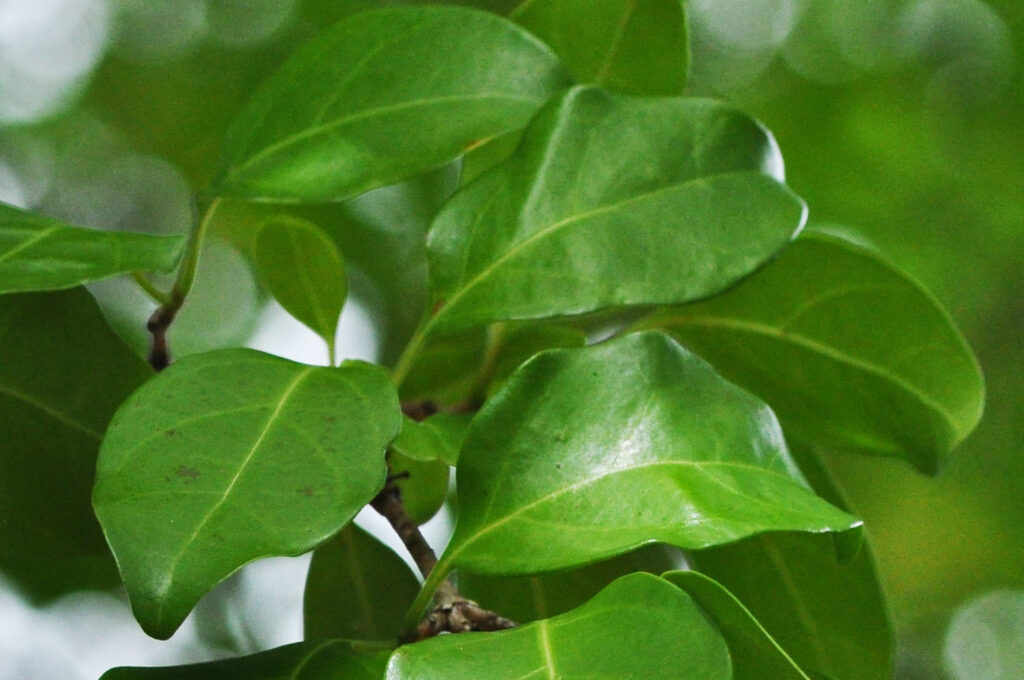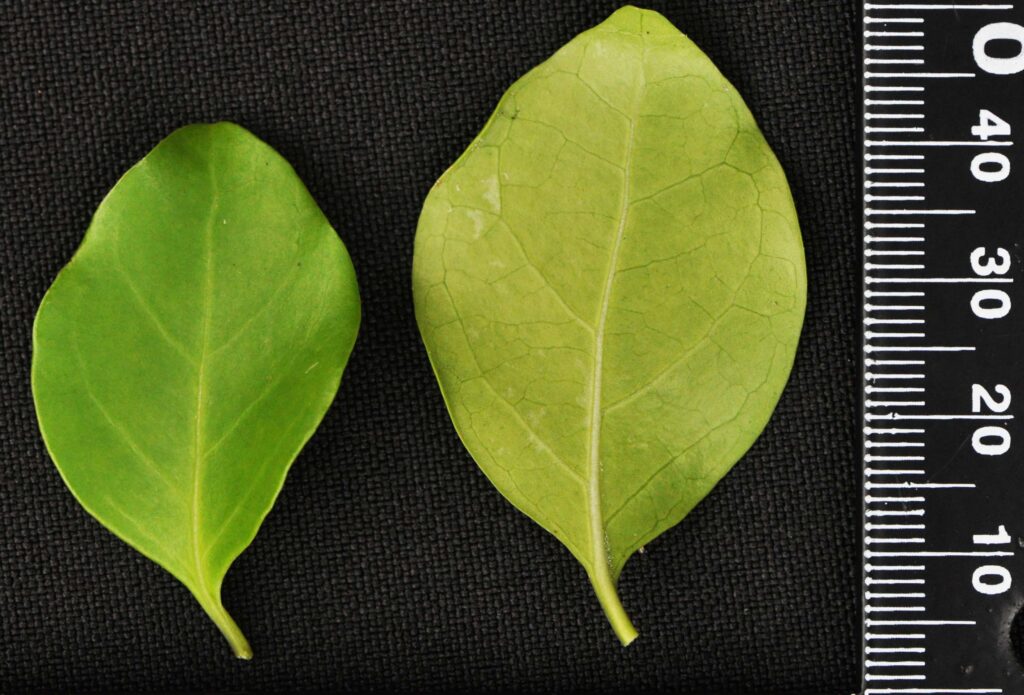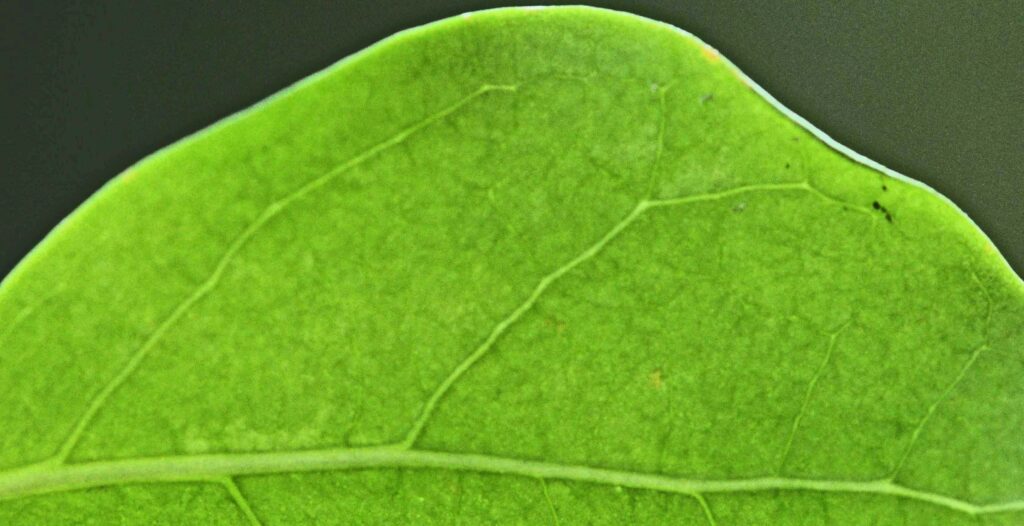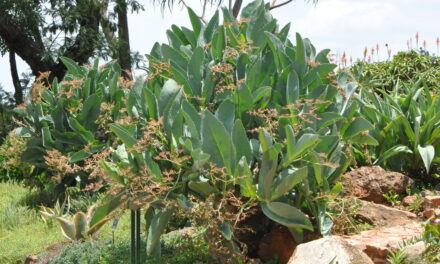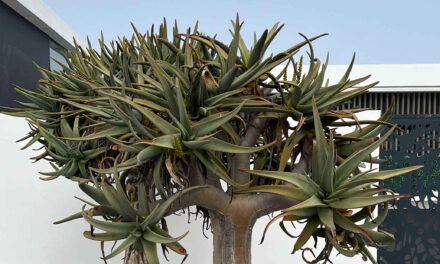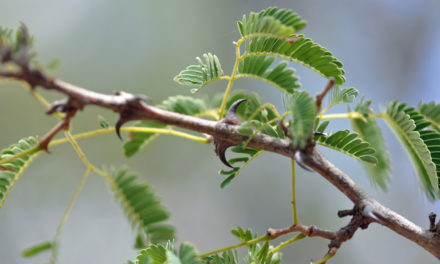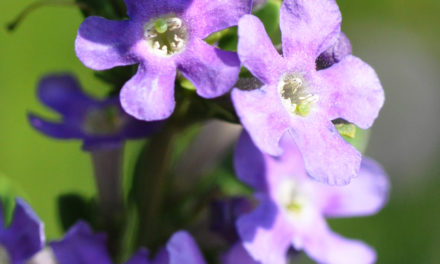Canthium inerme
General Info – summary
Tree with light to dark bark is up to 15m high, has decussate branches. Pairs of opposite, spines may be present. Simple ovate to oblong Leaves with entire margins are in opposite pairs near branch ends. Here domatia may be present. Minute greenish-yellow Flowers are in cymes and each rests on a short pedicel. They usually arise with new leaves. Wrinkled Fruit is an animal attracting drupe – aiding seed dispersal.
Description
Previous Names: Canthium swynnertonii, Canthium ventosum, Lycium inerme, Plectronia swynnertonii.
SA Tree No. 708.
Common names: (Afr) Bokdrolbessie, Bokdrolletjie, Bosdoringklipels, Doringels, Gewone Bokdrol, Skaapdrolletjie, Wolwedoring, Wildelemoentjie. (Eng) Cape Date, Turkey Berry, Unarmed Turkey-berry. (isiXhosa) Umnyushulube, Isiphingo. (isiZulu) Isitobe, Umvuthwamini, Umvuthwemini. (Northern Sotho) Mmutswa-o-sepela. (siSwati) Mvutwamira. (Tshivenda) Muvhibvela-shadani.
Family: Rubiaceae (Coffee/Gardenia family). This family of dicotyledonous plants has in excess of 600 genera and about 13 000 species and members include trees, shrubs and herbs. The plants are terrestrial and predominantly woody and sometimes Scandent (climbing without the aid of tendrils). Local genera with trees on this website include Afrocanthium, Canthium, Coddia, Gardenia, Pavetta, Rothmannia and Vangueria. Leaves are simple, opposite or whorled and have interpetiolar stipules. 4 or 5 merous, usually regular Flowers are bisexual or unisexual. The calyx has sepals that are at least partly united. Petals are joined – at least at the base. Stamens are usually as many as and alternating with corolla lobes. The Ovary is inferior. Fruit is a drupe, berry or capsule.
Name derivation: Canthium – from the Malabar (Indian) name: canti for a species of this genus. inerme – unarmed, defenceless, helpless: inaccurate name – thorns may be present. In southern Africa, about 15 species of Canthium are listed as trees.
Conservation: National Status: L C. (Least concern). Assessed: 2005 Raimondo et al. (2009).
Tree
This well-known semi-deciduous small Tree or shrub has a spreading crown and may reach 15m high in mountain forest but is usually up to 6m. It may also be a creeper. The Stem (or trunk is main axis of the plant, the leaf and flower bearing as distinguished from the root-bearing axis) is round or fluted and the colour varies from whitish to silver-white or pale grey (photo 946). It may be straight or branched and can reach a diameter in excess of 30cm. Twigs (1-year-old current branch segments) are thickish and covered with raised Lenticels (usually raised corky oval or elongated areas on the plant that allow the uncontrolled interchange of gases). Opposite pairs of slender, equal and straight paired stout Spines are up to 8cm long and usually develop at right angles to the stem – just above the nodes. Spines occur mainly in forest trees. Branches are decussate (arranged in opposite pairs at right angles to those above and below). The Bark on young trees is smooth and a clearly visible light grey (photo 946). It ages becoming rough (photo 939) and brown in forests.
- 946. 2018/09/15. Kirstenbosch NBG. Photo: David Becking.
- 939. 2018/09/15. Kirstenbosch NBG. Photo: David Becking.
Leaves
The softly leathery Leaves (photo 944) are hairless or with domatia (tiny chambers produced by plants that house arthropods. To the naked eye each domatium appears as a small bump) in vein axils. Leaves are simple (have a single blade, which may have incisions that are not deep enough to divide the leaf into leaflets). They are light glossy green above (photo 944), slightly lighter and less glossy below (photo 940). With the new plant growth, the leaves develop close to branch ends in opposite pairs. Leaves are ovate to oblong, lance-shaped or elliptic and up to 10 x 4,5cm (usually less – photo 940). The Apex and Base either taper or are rounded. Here the Midrib (the main rib of a leaf or leaf-like part, a continuation of the petiole) protrudes below (photos 940 & 944). In photo 943, taken against the sun, the pale side veins tend to loop before reaching the margin. The wavy and rolled under Margins are entire (with a continuous margin, not in any way indented). The base of the margin is slightly decurrent (here the leaf blades partly wrap around the Petiole (leaf stalk – photo 940). Here the smooth petiole is less than 1,5cm long. Each triangular Stipule (the basal appendages of the petiole), is shortly sheathing and up to 4mm long.
- 944. 2018/09/15. Kirstenbosch NBG. Photo: David Becking.
- 940. 2018/09/15. Kirstenbosch NBG. Photo: David Becking.
- 943. 2018/09/15. Kirstenbosch NBG. Photo: David Becking.
Flowers
The very small (up to 3mm long), slightly sweet-scented, greenish-yellow Flowers with white, hairy throats develop in leaf axils in dense clusters. Inflorescences have 4-40 short-branched heads (up to 3cm in diameter) contained within a Cyme (a broad, more or less flat-topped, determinate flower cluster, with central flowers opening first) that has 2 secondary axes. Each flowers rest on a short Pedicel (stalk of a single flower) and often arises with the new leaves. The Calyx is saucer or basin shaped. The Petals in the yellow-green Corolla have a broadly cylindrical tube ending with reflexed lobes. The flowers are Monoecious (having both male and female reproductive organs on the same plant) and here each flower (N.B. not the whole plant) is functionally male or female. In functionally Male Flowers, the Stamens arise from the corolla mouth. The Filaments are usually shorter than the Anthers. The Disc (a more or less fleshy or elevated development of the receptacle) is annular. In functionally Female Flowers, the inferior, 2-locular Ovary has a single pendulous Ovule in each locule. An almost spherical Pollen Presenter situated at the tip of the Style (a more or less elongated part of the pistil situated between the ovary and the stigma). The function of the pollen presenter is to promote cross fertilization. The hairless Style is narrowly clavate (thickened towards the top, like a baseball bat) and slightly longer than the corolla tube. (Aug-Jan).
Fruit
The Fruit rests on a long Pedicle (flower stalk) and is an oblong to ovoid, 1 or slightly 2-lobed, Drupe (stone fruit). It is a fleshy, indehiscent fruit with the seed enclosed in a stony endocarp – like a peach. Outside this is a fleshy Mesocarp surrounded by the skin or exocarp. The drupe may be 2-seeded, is initially shiny green and usually up to 1,5 x 1cm. It ripens to become purple or black, wrinkled and has a round scar at the apex. Fallen fruits resemble goat or sheep droppings – hence some of the common names. (Oct-Apr). The Fruit may remain on the tree for many months.
Distribution & Ecology
This is a typically scattered tree that often develop close to the sea. Apart from this, these trees occur from sea sands, within kloofs (steep-sided, wooded ravines or valleys), subtropical bushveld and scrub up to an altitude of 2 000m. At higher altitudes they are usually among rocks. These plants are common on grasslands, and near to streams. They are absent from most arid areas and the wettest forests. In South Africa this plant is located in the Western and Eastern Cape, KwaZulu-Natal especially the southern coast, Mpumalanga, Gauteng, North West and Limpopo. Beyond South Africa they occur in Eswatini (Swaziland), central and southern Mozambique and Eastern Zimbabwe. They are thus endemic in Southern Africa. Domatia may be present. To the naked eye, the domatia appear as small bumps and are present in leaf vein axils. These domatia are usually not hairy. Many birds, including the African Olive Pigeons (Columba arquatrix) relish the fallen Fruit that is borne in great abundance and often disperse the seeds. Pollination agents include bees. The tree Leaves and those of Volkameria glabra, Munduela sericea and others are hosts for the larvae of the Natal Bar or Natal Barred Blue or Natal Silverline Butterfly (Cigaritis natalensis). “Blue” refers to the colour of the open wings. Adults are on wing year round – peaking from March to May.
Ethnobotany
The Trees are used to shelter stock. The attractive, extremely tough, hard Wood is dense, close-grained, finishes and takes varnish well. It is yellow or light brown and has a marbled grain. Uses include fence poles, implement handles, fuel and wagon wheel felloes (the outer rim of the wheel). Large pieces of wood seldom develop. Traditional medicine makes use of the Leaves. The slightly insipid Fruit is edible.
References
Boon, R. 2010. Pooley’s Trees of eastern South Africa. Flora and Fauna Publications Trust, Durban.
Burrows, J.E., Burrows, S.M., Lotter, M.C. & Schmidt, E. 2018. Trees and Shrubs Mozambique. Publishing Print Matters (Pty) Ltd. Noordhoek, Cape Town.
Coates Palgrave, M. 2002. Keith Coates Palgrave Trees of Southern Africa, edn 3. Struik, Cape Town.
Foden, W. & Potter, L. 2005. Canthium inerme (L.f.) Kuntze. National Assessment: Red List of South African Plants version . Accessed on 2024/10/05.
Ginn P.J. Mcilleron W.G. and Milstein P. le S, 1989. The Complete Book of Southern African Birds. Struik, Cape Town.
Lawrence, G. H. M, 1951. Taxonomy of Vascular Plants. The Macmillan Company, New York. Tenth Printing 1965.
Palmer, E. & Pitman, N. 1972. Trees of southern Africa. Balkema, Amsterdam, Cape Town.
Schmidt, S. Lotter, M. & McCleland, W. 2002. Trees and Shrubs of Mpumalanga and the Kruger National Park. Jacana, Johannesburg.
van Wyk, B. & van Wyk, P. 1997 Field guide to Trees of Southern Africa. Struik, Cape Town.
Woodhall, S. 2020. Field Guide to Butterflies of South Africa, edn 2. Donnelley, RR, China.
https://www.flickr.com/photos/52450054@N04/42582854252
http://plantinfo.co.za/plant/canthium-inerme/
http://tropical.theferns.info/viewtropical.php?id=Canthium+inerme
http://posa.sanbi.org/flora/browse.php?src=SP
https://en.wikipedia.org/wiki/Cigaritis_natalensis
https://en.wikipedia.org/wiki/Rubiaceae

